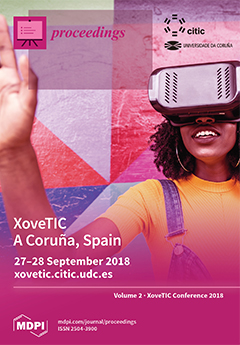Need Help?
Proceedings, 2018, XoveTIC 2018
XoveTIC 2018
A Coruña, Spain | 27–28 September 2018
Issue Editors:
Ignacio Fraga, University of A Coruña, Spain
Alberto Alvarellos, University of A Coruña, Spain
Maria Montero, University of A Coruña, Spain
Javier Pereira, University of A Coruña, Spain
Manuel González Penedo, University of A Coruña, Spain
Printed Edition Available!
- Issues are regarded as officially published after their release is announced to the table of contents alert mailing list.
- You may sign up for e-mail alerts to receive table of contents of newly released issues.
- PDF is the official format for papers published in both, html and pdf forms. To view the papers in pdf format, click on the "PDF Full-text" link, and use the free Adobe Reader to open them.
Cover Story (view full-size image):
This issue of Proceedings gathers papers presented at XOVETIC2018 (A Coruña, Spain, 27–28 September 2018), a conference with the main goal of bringing together young researchers working
[...] Read more.
This issue of Proceedings gathers papers presented at XOVETIC2018 (A Coruña, Spain, 27–28 September 2018), a conference with the main goal of bringing together young researchers working in big data, artificial intelligence, Internet of Things, HPC(High-performance computing), cybersecurity, bioinformatics, natural language processing, 5G and others areas from the field of ICT(Information Communications Technology), and offering a platform to present the results of their research to a national audience in the north of Spain.
This first edition aims to serve as the basis of this event, which will be consolidated over time and acquire international projection.
This first edition aims to serve as the basis of this event, which will be consolidated over time and acquire international projection.
Previous Issue
Next Issue
Issue View Metrics
Multiple requests from the same IP address are counted as one view.



